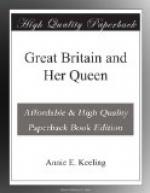[Illustration: Dean Church.]
English letters have suffered by the removal of many whose services in one way or another have been great: the prose-painter Richard Jefferies; the pure and beneficent Mrs. Craik, better known as Miss Muloch; Matthew Arnold, poet, educationalist, critic, whose verse should outlive his criticisms; the noble astronomer Richard Proctor; Gustave Masson, the careful biographer of Milton; Laurence Oliphant, gifted and eccentric visionary; the naturalist J. G. Wood; the explorer and orientalist Burton; the historians Kinglake, Froude, and Freeman; the great ecclesiastics Bishop Lightfoot, Canon Liddon, Archbishop Magee of York, Dean Church, Dean Plumptre, and the Cardinals Newman and Manning; Tennyson and Browning, poets whose mantle has yet fallen on none; Huxley and Tyndall, eminent in science; the justly popular preacher and writer Charles H. Spurgeon; the orator and philanthropist John Bright, whose speeches delight many in book-form; and Robert Louis Stevenson, novelist, essayist, poet. To these we may add Eliza Cook and Martin Tapper, widely popular a generation ago, and surviving into our own day; Lord Lytton, known as “Owen Meredith,” a literary artist, before he became viceroy of India and British ambassador at Paris; and Professor Henry Drummond, dead since 1897 began, and widely known by his “Natural Law in the Spiritual World.” Even so our list is far from complete.
[Illustration: J. E. Millais, P.R.A. From a Photograph by Elliott & Fry.]
Of painters and sculptors we have lost since 1887 Frank Holl; Sir Edgar Boehm, buried in St. Paul’s by express wish of the Queen; Edwin Long; John Pettie; Sir Noel Paton; Sir Frederick Leighton; and Sir J. E. Millais. The last two illustrious painters were successively Presidents of the Royal Academy, Millais, who followed Leighton in that office, surviving him but a short time. Sir Frederick had been raised to the peerage as Lord Leighton only a few days before he died, the patent arriving too late for him to receive it.
[Illustration: Sir Frederick Leighton, P.R.A. From a Photograph by J. R. Mayall, Piccadilly, W.]
The English world is the poorer for these many losses, some of which took place under tragic circumstances; yet hope may well be cherished that amongst us are those, not yet fully recognised, who will nobly fill the places of the dead. Some hymn-writer may arise whose note will be as sweet as that of the much loved singer, Dr. Horatius Bonar, some painter as spiritual and powerful as Paton, some poet as grandly gifted as the late laureate and his compeer Browning. We do not at once recognise our greatest while they are with us; therefore we need not think despairingly of our age because the good and the great pass away, and we see not their place immediately filled. Nor, though there be great and crying evils in our midst, need we tremble lest these should prevail, while there is so much earnest and energetic endeavour to cope with and overcome them.




